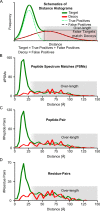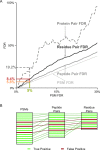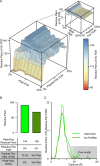Quirks of Error Estimation in Cross-Linking/Mass Spectrometry
- PMID: 28267312
- PMCID: PMC5423704
- DOI: 10.1021/acs.analchem.6b03745
Quirks of Error Estimation in Cross-Linking/Mass Spectrometry
Abstract
Cross-linking/mass spectrometry is an increasingly popular approach to obtain structural information on proteins and their complexes in solution. However, methods for error assessment are under current development. We note that false-discovery rates can be estimated at different points during data analysis, and are most relevant for residue or protein pairs. Missing this point led in our example analysis to an actual 8.4% error when 5% error was targeted. In addition, prefiltering of peptide-spectrum matches and of identified peptide pairs substantially improved results. In our example, this prefiltering increased the number of residue pairs (5% FDR) by 33% (n = 108 to n = 144). This number improvement did not come at the expense of reduced accuracy as the added data agreed with an available crystal structure. We provide an open-source tool, xiFDR ( https://github.com/rappsilberlab/xiFDR ), that implements our observations for routine application. Data are available via ProteomeXchange with identifier PXD004749.
Conflict of interest statement
The authors declare no competing financial interest.
Figures



Similar articles
-
An algorithm for decoy-free false discovery rate estimation in XL-MS/MS proteomics.Bioinformatics. 2024 Jun 28;40(Suppl 1):i428-i436. doi: 10.1093/bioinformatics/btae233. Bioinformatics. 2024. PMID: 38940171 Free PMC article.
-
Folic acid supplementation and malaria susceptibility and severity among people taking antifolate antimalarial drugs in endemic areas.Cochrane Database Syst Rev. 2022 Feb 1;2(2022):CD014217. doi: 10.1002/14651858.CD014217. Cochrane Database Syst Rev. 2022. PMID: 36321557 Free PMC article.
-
LinX: A Software Tool for Uncommon Cross-Linking Chemistry.J Proteome Res. 2021 Apr 2;20(4):2021-2027. doi: 10.1021/acs.jproteome.0c00858. Epub 2021 Mar 3. J Proteome Res. 2021. PMID: 33657806
-
FineFDR: Fine-grained Taxonomy-specific False Discovery Rates Control in Metaproteomics.Proceedings (IEEE Int Conf Bioinformatics Biomed). 2022 Dec;2022:287-292. doi: 10.1109/bibm55620.2022.9995401. Epub 2023 Jan 2. Proceedings (IEEE Int Conf Bioinformatics Biomed). 2022. PMID: 36910011 Free PMC article.
-
Towards low false discovery rate estimation for protein-protein interactions detected by chemical cross-linking.Biochim Biophys Acta Proteins Proteom. 2021 Jul;1869(7):140655. doi: 10.1016/j.bbapap.2021.140655. Epub 2021 Mar 31. Biochim Biophys Acta Proteins Proteom. 2021. PMID: 33812047 Review.
Cited by
-
Mono- and Intralink Filter (Mi-Filter) To Reduce False Identifications in Cross-Linking Mass Spectrometry Data.Anal Chem. 2022 Dec 27;94(51):17751-17756. doi: 10.1021/acs.analchem.2c00494. Epub 2022 Dec 12. Anal Chem. 2022. PMID: 36510358 Free PMC article.
-
Inferring Protein-Protein Interaction Networks From Mass Spectrometry-Based Proteomic Approaches: A Mini-Review.Comput Struct Biotechnol J. 2019 Jun 20;17:805-811. doi: 10.1016/j.csbj.2019.05.007. eCollection 2019. Comput Struct Biotechnol J. 2019. PMID: 31316724 Free PMC article. Review.
-
MORC2 is a phosphorylation-dependent DNA compaction machine.Nat Commun. 2025 Jul 1;16(1):5606. doi: 10.1038/s41467-025-60751-z. Nat Commun. 2025. PMID: 40593625 Free PMC article.
-
Structural basis for Mis18 complex assembly and its implications for centromere maintenance.EMBO Rep. 2024 Aug;25(8):3348-3372. doi: 10.1038/s44319-024-00183-w. Epub 2024 Jul 1. EMBO Rep. 2024. PMID: 38951710 Free PMC article.
-
Capturing protein communities by structural proteomics in a thermophilic eukaryote.Mol Syst Biol. 2017 Jul 25;13(7):936. doi: 10.15252/msb.20167412. Mol Syst Biol. 2017. PMID: 28743795 Free PMC article.
References
Publication types
Grants and funding
LinkOut - more resources
Full Text Sources
Other Literature Sources
Molecular Biology Databases

